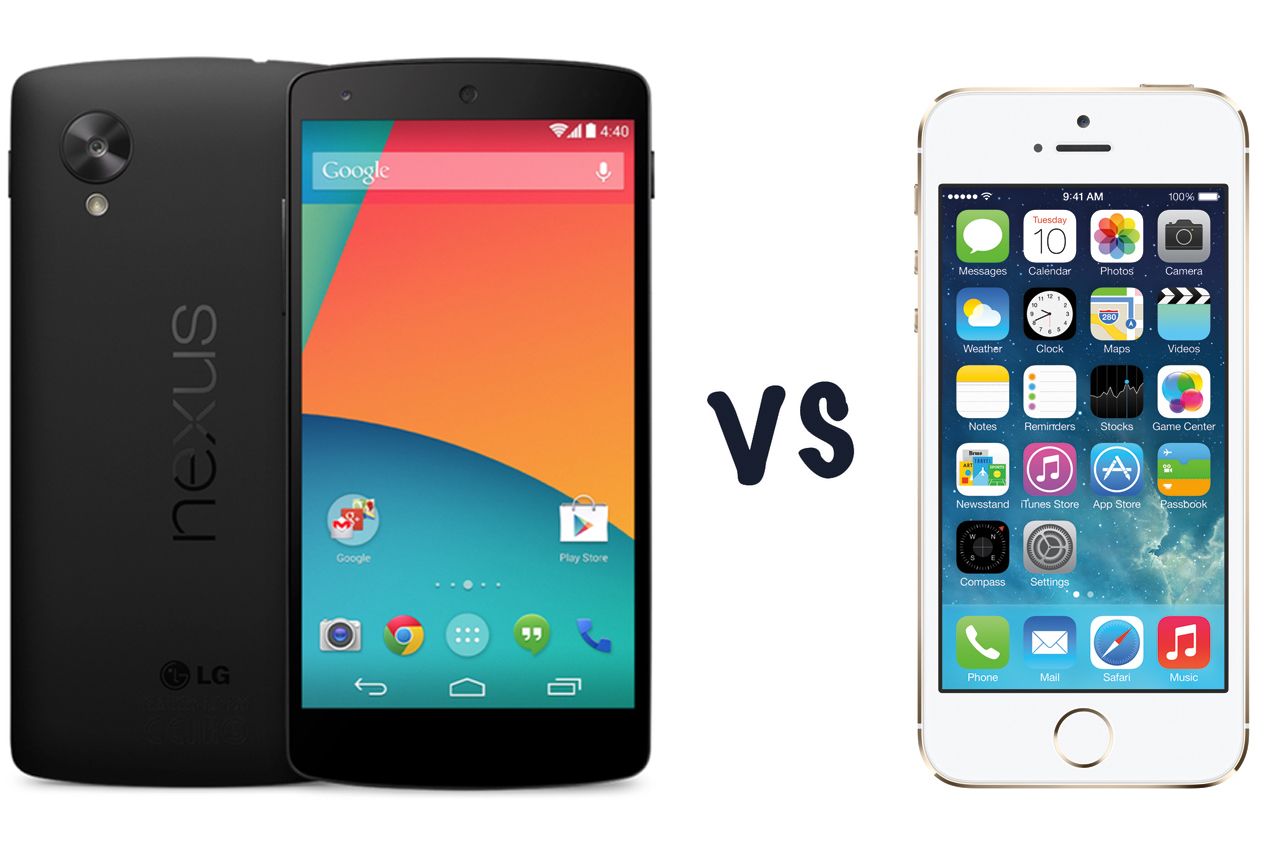Comparing an Android phone and an iOS one is always tough. But with Google and Apple as the two biggest names in tech it would be a crime to ignore the head-to-head that is the Nexus 5 versus the iPhone 5S.
So can Google's limited number of years dealing with hardware already be enough to challenge the well-established iPhone 5S? Has Google undercut in price while offer as many, even more, specs? And will Android's popularity continue to outsell the iPhone's?
Read: Apple iPhone 5S review
Design and display
In true smartphone fashion the Nexus 5 is larger than its predecessor, but not by much. The Nexus 5 comes in at 5-inches in screen size and the resolution has been given a bump to 1920×1080 display (445 ppi). The iPhone 5S, by comparison, has a 4-inch, 1136 x 640 pixel (326ppi) Retina display. When you hear the specs side by side like that you have to ask what Retina even stands for anymore.
The iPhone 5S measures in at 123.8 x 58.6 x 7.6mm and 112g. The Nexus 5 is a larger 137.84 x 69.17 x 8.59mm and a heavier 130g. While the iPhone offers a better profile here and nice slim body, it does so at the cost of a larger screen. The difference in weight isn't huge so on this comparison it really comes down to personal preference.
Power showdown
As expected the latest Google smartphone is packing much more power than the last. It's shipping with the very fashionable Qualcomm Snapdragon 800 quad-core processor running at a hand-melting 2.26GHz. That's backed by a healthy 2GB RAM to keep everything zipping along. While Apple isn't about specs so much it's still pulling now punches in this area with its new A7 processor which is capable of 64-bit processing essentially making it future-proof while delivering double the power of its predecessor. In benchmark tests between the Snapdragon 800 in an LG G2 (basically the Nexus 5) and an A7 processor in the iPHone 5S Apple comes out on top. Geekbench gives the iPhone 5S a 2557 score and the G2 a 2154. We'll have to wait and see if the Nexus 5, minus the LG skin, is faster.
Thanks to the Snapdragon 800 the Nexus 5 is future-proofed for outputting 4K video, something the iPhone 5S is touted by Apple as being able to manage.
But Apple takes an extra point for its M7 processor which works alongside the main unit to calculate movement data at a very accurate level. This essentially turns the phone into a personal tracker and allows games and apps to use even more detailed information. It'll be interesting to see how much developers use this and if that leads to greater apps over the Android offerings.
Battery powers
When it comes to literal power the new Nexus 5 will come with a 2300mAh battery which, with a larger, higher resolution screen but more efficient processor than its predecessor, should eek about some more life. This should deliver around 10 hours of battery life, the same amount Apple claims the iPhone 5S can manage.
This is a very subjective area, though and really depends on how a person uses the phone.
Camera abilities
The Nexus 5 comes with and optical image stabilisation 8-megapixel rear and 1.3-megapixel front-facing cameras.
The iPhone 5S has a larger sensor and wider aperture than before at f/2.4 for better low light shots. A dual bulb flash allows for True Tone which creates a well balanced image. The front-facing camera can now shoot in 720p while the rear is able to film in slo-mo.
The Nexus 5 camera is now equipped with Photo Sphere for knitted 360-degree shots, HDR+ which takes burst shots and automatically choses the best, and Auto Awesome which appears to improve photos in your library to share - much like Google+ does.
Software stand-off
The problem with Android is that less than half of Android devices where running the Jelly Bean OS in 2012 while two thirds of Apple devices are already on iOS 7. KitKat aims to address that by working across the board on all devices - even more affordable handsets. Also this makes it perfect for wearable tech too. Just saying.
KitKit offers new features such as NFC support, NFC services assistance, and being able to use your phone as a remote control for your TV.
iOS 7 provides an entirely new looks, an improved notifications centre, a quick settings panel, new camera options, more sounds and ringtones, and iuversal search.
So while both operating systems have been improved it feels like iOS 7 is more aesthetic whereas Android 4.4 KitKat is a big play by Google to help bring its entire market up to speed.
Conclusion
The last consideration has to be price. Then, if that's not an issue, it's down to personal preference of freedom with Android of slick tidy iOS.
The Google Nexus 5 with 16GB will cost you £295.
The iPhone 5S with 16GB will cost you £550.

